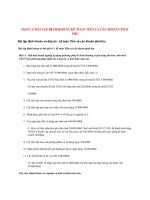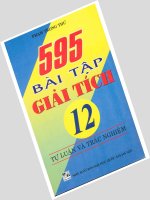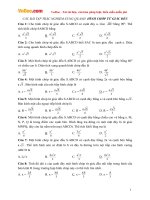Tải Bài tập Tiếng Anh lớp 9 Unit 4: Life in the past nâng cao - Ôn tập tiếng Anh 9 thí điểm theo từng Unit có đáp án
Bạn đang xem bản rút gọn của tài liệu. Xem và tải ngay bản đầy đủ của tài liệu tại đây (102.34 KB, 8 trang )
<span class='text_page_counter'>(1)</span><div class='page_container' data-page=1>
<b>Bài tập Tiếng Anh lớp 9 </b>
<b> Unit 4: Life in the past nâng cao</b>
<i><b>Bản quyền thuộc về upload.123doc.net nghiêm cấm mọi hành vi sao chép vì mục đích thương</b></i>
<i><b>mại</b></i>
<b>Exercise 1: Choose the word whose underlined part is pronounced differently from</b>
<b>the others.</b>
1. A. emotion B. indecisive C. obesity D. believable
2. A. entertain B. event C. dogsled D. domed
3. A. fresh B. specific C. e ntertain D. preservation
4. A. increase B. surprise C. release D. promise
5. A. occasion B. vendor C. mobile D. technological
<b>Exercise 2: Choose a word in each line that has different stress pattern</b>
1. A. develop B. understand C. imagine D. consider
2. A. grandparent B. violence C. buffalo D. importance
3. A. illiterate B. communicate C. entertainment D. traditional
<b>Exercise 3: Complete the sentence with the correct tense of the verb in brackets</b>
1. This used (be) the best restaurant in town.
2. If you (go) to bed earlier, you (not be) so tired.
3. I only wish you (be) all as happy as I am.
4. We are having a wonderful holiday on the beach. I wish you _______(be) here.
5. He is always whistling. I wish he ________ (not do) that all the time.
<b>Exercise 4: Choose the correct answer A, B, C or D</b>
1. The children were acting _______________the story of the birth of Jesus.
A. out
B. on
C. down
D. at
</div>
<span class='text_page_counter'>(2)</span><div class='page_container' data-page=2>
B. watched
C. was watching
D. would watch
3. Unfortunately the new system didn’t _________ our expectations.
A. catch up with
B. bring about
C. come across
D. come up to
4. Working as street vendors has created countless jobs, and it has become __________in
Ha Noi.
A. part of life
B. parts of life
C. part of lives
D. life parts
5. “Quang ganh” is two baskets hung from either end of a bamboo pole_________the
shoulders.
A. across
B. at
C. on
D. above
6. I’ve just found 20 dollars in my pocket! - _________!
A. How crazy
B. That’s right
C. Thanks a lot
D. How cool
7. When I see the kids playing football, I almost wish I _______ their age again.
A. was
</div>
<span class='text_page_counter'>(3)</span><div class='page_container' data-page=3>
C. would be
D. could be
8. Youngsters love to eat from street___________for the cheap price.
A. vans
B. vendors
C. trucks
D. business
9. Viet Nam’s tug-of-war game was also ____________as a UNESCO cultural intangible
heritage of humanity in December 2015.
A. realised
B. recognised
C. allowed
D. seen
10. We all wish there_________a smart board in our classroom.
A. is
B. was
C. has been
D.had been
<b>Exercise 5: Choose the word or phrase among A, B, C or D that best fits the blank</b>
<b>space in the following passage</b>
It is just simple and ordinary as its (1)__________. No noisy sound from engines, no
obscure smoke and no spending too much for commuting. From a long time ago,
Vietnamese people have thought of the rickshaw as a (2)__________means of
transportation when going out. It is not only close-knit to Vietnamese but also connected
strongly with the foreigners (3)__________all of them were attracted by this unique
means at the first time visiting Viet Nam.
</div>
<span class='text_page_counter'>(4)</span><div class='page_container' data-page=4>
Traveling in a rickshaw is the time for peacefully(8)__________windy sunset and bright
sunrises on the beach of Nha Trang or Da Nang or elsewhere. How pleasant it is for you
to enjoy a relaxing feeling on the short (9)__________trip.
Viet Nam is becoming more and more modern; however, rickshaw still
(10)__________through the time and has a stand in the minds of the residents.
1. A. presence B. appearance C. judgment D. performance
2. A. shared B. recognized C. friendly D. familiar
3. A. although B. as C. but D. while
4. A. breath B. air C. rest D. recovery
5. A. close B. closed C. closest D. closing
6. A. sight B. sighting C. sightseeing D. sightseer
7. A. catch B. take C. bring D. keep
8. A. welcome B. welcoming C. welcomed D. being welcomed
9. A. city B. town C. urban D. field
10. A. keeps B. continues C. lives D. survives
<b>Exercise 6: Choose the underlined word or phrase (A, B, C or D) that needs</b>
<b>correcting</b>
1. Lynn wishes (A) she had (B) a bigger apartment and can (C) buy (D) a car.
2. He let (A) the letter falling (B) onto (C) the floor (D).
3. I wish I have (A) his mobile phone number so that (B) we could (C) tell him the good
news (D).
<b>Exercise 7: Read the passage and choose the correct answer A, B, C or D</b>
For formal ceremonies, men would have two additional items, a long gown with slits on
either side, and a turban, usually in black or brown made of cotton or silk. In feudal
times, there were strict dress codes. Ordinary people were not allowed to wear clothes
with dyes rather than black, brown or white. Costumes in yellow were reserved for the
King. Those in purple and red were reserved for high ranking court officials, while
dresses in blue were exclusively worn by petty court officials. Men's dress has gradually
changed along with social development.
</div>
<span class='text_page_counter'>(5)</span><div class='page_container' data-page=5>
trousers. Traditional costumes still exist and efforts are increasingly being made to
restore traditional festivals and entertainment which incorporate traditional costumes.
For women, the outer garment is a special silk gown called an “ao tu than” which is
brown or light brown in colour with four slits divided equally on its lower section.The
second layer is a gown in a light yellow colour and the third layer is a pink gown. When a
woman wears her three gowns, she fastens the buttons on the side, and leave those on the
chest unfastened so that it forms a shaped collar. This allows her to show the different
colors on the upper part of the three gowns. Today, on formal occasions women wear “ao
dai”.
1. In the past, the colour was used to represent ____________.
A. the difference between men and women
B. formal ceremonies
C. the social development
D. the rank in the society
2. In the past, for formal ceremonies men wore .
A. costumes in purple or yellow not like the King
B. a long gown and a turban in black or brown
C. costumes made of red cotton or silk
D. dresses in blue as petty court officials
3. Traditional festivals____________.
A. promote traditional costumes
B. encourage modern-looking suits
C. replace traditional suits by business ones
D. make men’s dresses change
4.All of the following are true about women’s traditional costumes EXCEPT that
________.
A.the gowns have different colours on the upper part
B.we can see a shaped collar in the front
C.the two inner gowns cannot be seen
</div>
<span class='text_page_counter'>(6)</span><div class='page_container' data-page=6>
5. The word “gown” in paragraph 1 is closest in meaning to _________.
A.a long dress worn on formal occasions
B.a woman’s dress, especially a long one
C.a long piece of clothing worn by judges
D. piece of clothing that is worn over other clothes to protect them
<b>Exercise 8: Complete the second sentence so that it has the same meaning as the first</b>
<b>sentence.</b>
1. It’s a pity my computer is out of order.
I wish ____________________________________
2. He doesn’t have meals with his family any more.
He used ___________________________________
3. It took me a long time to be accustomed to living in the country.
It took me a long time to get ___________________
4. I would like my sister to improve her English speaking.
I wish _____________________________________
5. Vietnamese people only eat dried candied fruit at Tet.
Dried candied fruit ___________________________
<b>-The </b>
<b>end-Đáp án bài tập Tiếng Anh lớp 9 </b>
<b> Unit 4: Life in the past</b>
<b>nâng cao</b>
<b>Exercise 1: Choose the word whose underlined part is pronounced differently from</b>
<b>the others.</b>
1. C 2. D 3. B 4. B 5. C
<b>Exercise 2: Choose a word in each line that has different stress pattern</b>
1. B 2. D 3. C
<b>Exercise 3: Complete the sentence with the correct tense of the verb in brackets</b>
1. This used to be (be) the best restaurant in town.
</div>
<span class='text_page_counter'>(7)</span><div class='page_container' data-page=7>
3. I only wish you were (be) all as happy as I am.
4. We are having a wonderful holiday on the beach. I wish you ___were____(be) here.
5. He is always whistling. I wish he ___didn’t do_____ (not do) that all the time.
<b>Exercise 4: Choose the correct answer A, B, C or D</b>
1. A 2. B 3. D 4. A 5. C
6. D 7. A 8. B 9. B 10. B
<b>Exercise 5: Choose the word or phrase among A, B, C or D that best fits the blank</b>
<b>space in the following passage</b>
1. B 2. A 3. C 4. D 5. B
6. A 7. D 8. C 9. B 10. C
<b>Exercise 6: Choose the underlined word or phrase (A, B, C or D) that needs</b>
<b>correcting</b>
1. C (can => could)
2. B (falling => fall)
3. A (have => had)
<b>Exercise 7: Read the passage and choose the correct answer A, B, C or D</b>
1. D 2. B 3. A 4. C 5. A
<b>Exercise 8: Complete the second sentence so that it has the same meaning as the first</b>
<b>sentence.</b>
1. I wish my computer wasn’t out of order
2. He used to have meals with his family.
3. It took me a long time to get used to living in the country.
4. I wish my sister improved her English speaking.
5. Dried candied fruit is only eaten by Vietnamese people at Tet.
</div>
<span class='text_page_counter'>(8)</span><div class='page_container' data-page=8></div>
<!--links-->









